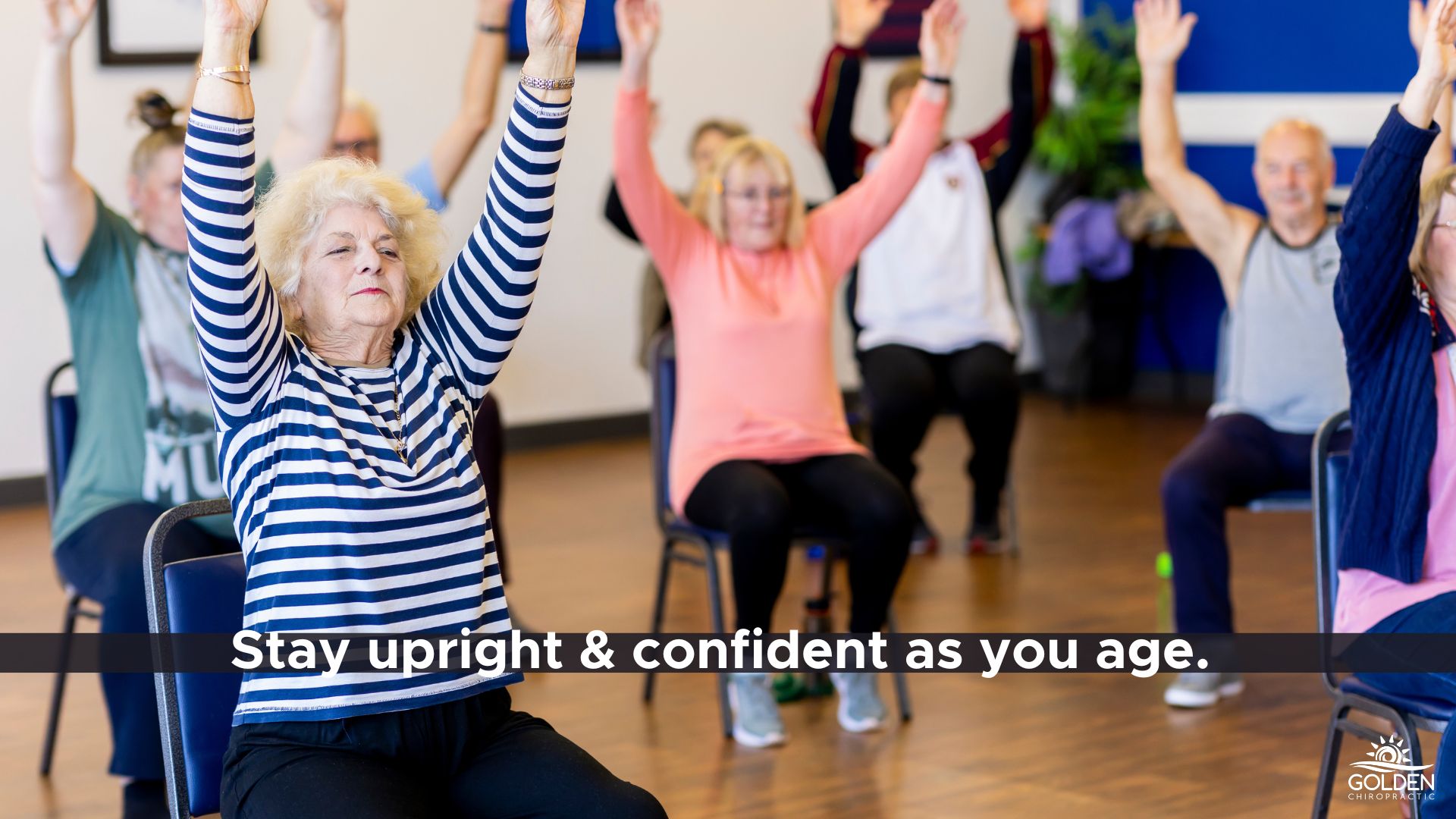
10/08/2025 by Dr. Joe Bell
You Don’t Have to Get More Hunched-Over as You Age
Many of my older patients joke about getting “a little more hunched every year.” And while I may laugh a bit with them, I also try to emphasize that feeling more bent over each year is really not a joke.
That bent-over posture we often see with aging can have quite a few negative effects—including stiffness, fatigue and shortness of breath.
But it doesn't have to get really bad. You can stay strong and more upright with the right care. You can also learn to manage those age-related posture changes.
But first, why do people get more hunched over as they age?
As we age, gravity, posture habits, and decades of tiny spinal stresses can start to show up as that rounded upper back we call hyperkyphosis.
Some of this rounding happens because of structural changes in the bones and joints—what I call structural hyperkyphosis.
Some rounding can also come from muscle imbalances and posture patterns, known as functional hyperkyphosis.
Usually hyperkyphosis is a combination of structural and functional causes.
The good news is that chiropractic care can help, regardless of cause.
While we can’t reverse the structural changes that come with time, we CAN help your spine and muscles move better. We can also ease your discomfort, and slow the progression of hyperkyphosis.
With some professional care and self-care, you can stay strong, upright, and confident in your body.
Suffering from hyperkyphosis isn't necessarily a requirement of getting old.
You don't have to accept it. You can take steps to feel and function better.
I had one patient in her late 70s who came in worried about her posture.
She was also struggling to lift her arms overhead.
She’d been avoiding care because of her osteoporosis and fragile bones (please don't avoid care for fear of fragility. We can work with your osteoporosis).
After a gentle exam and conversation, she felt comfortable trying chiropractic treatment.
Using light myofascial release and an activator tool, we focused on improving mobility through her upper back and shoulders.
Within a few weeks, she could reach into her cupboards again without strain!
She told me she hadn’t realized chiropractic care could be so gentle and effective. Moments like that are why I love what I do.
So what’s really going on when that rounded posture starts to appear?
For most people, it’s a combination of both bone and muscle changes.
Over time, the small joints and discs in your thoracic spine wear down from years of posture habits, gravity, and little “micro-traumas” that add up.
The vertebrae can start to wedge forward, creating that curve through the upper back.
There are also hormonal and mineral changes that affect bone density as we age. Lower estrogen or testosterone, plus reduced calcium absorption, make the structure of your spine more vulnerable.
On top of that, when your chest muscles stay tight and your upper-back muscles weaken, your body naturally pulls forward. The modern postural habits that come with technology use definitely encourage this muscle imbalance.
When you start to see the classic hunch forming, it's a combination of natural aging and years of your lifestyle habits catching up.
That forward curve doesn’t just change how you look—it changes how your body feels and functions.
When your spine rounds forward, your ribcage can’t expand as easily, which makes deep breathing harder.
The muscles along your back and neck work overtime just to hold you upright, leading to stiffness, fatigue, and even tension headaches.
Over time, that shift in balance puts more pressure on your hips, knees, and feet, increasing your fall risk.
And let’s be honest—seeing your posture change can take a toll emotionally, too.
Many of my patients tell me they feel “older” or less confident when they notice that curve showing up in the mirror.
When that rounded posture goes unchecked, the body slowly adapts to the new position—and not in a good way.
The more your spine curves forward, the more those spinal joints stiffen and lose their natural motion.
Over time, standing tall or looking straight ahead becomes harder and harder. You might start to notice that you tire out faster while walking, or that reaching overhead feels almost impossible.
Left untreated, hyperkyphosis can also speed up bone and joint degeneration, putting more stress on your neck and lower back.
Even simple daily tasks—like cooking, gardening, or dressing—can start to feel exhausting.
Ignoring it doesn’t just limit what your body can do; it chips away at your independence and confidence.
The earlier you address it, the more we can help you stay mobile and prevent those changes from becoming permanent.
The good news is that there’s a lot we can do to help.
Chiropractic care for hyperkyphosis focuses on restoring gentle motion and improving muscle function.
At Golden Chiropractic, we use gentle techniques, like:
- Myofascial release to loosen tight chest and shoulder muscles
- An activator tool to safely encourage movement in the upper and mid-back
For patients with osteoporosis or advanced arthritis, these gentle, low-force methods are both safe and effective.
We also work together on simple mobility drills and posture retraining so your body learns to move in a more upright, balanced way.
With regular care, many patients notice easier breathing, less stiffness, and better balance within just a few weeks.
Our focus for hyperkyphosis is helping your spine move the way it was designed to. This helps you move through life more comfortably and confidently.
What you do at home can also make a HUGE difference in keeping that forward curve from progressing.
The key is to help yourself avoid deepening hyperkyphosis by keeping your spine moving and your posture muscles strong.
I usually start my patients with simple, gentle movements. I often advise chin tucks, shoulder rolls, and thoracic extensions over a rolled-up towel.
Doorway stretches for the chest and banded rows for the upper back open the front of your body and strengthen the muscles that keep you upright.
Breathing exercises also help expand your ribcage and reduce that “compressed” feeling.
Remember: the little things add up!
Change your positions while reading. Look up from your phone. Take short walks throughout the day. These all support a healthier, more upright posture.
Daily maintenance for your spine can make the most difference. Especially if your work or lifestyle encourages a lot of sitting or maintaining one posture over the course of the day.
And daily self-care really does help, but …
There are certain times when you need to seek care.
If you notice your posture getting more rounded, or if standing tall feels harder than it used to, it’s time to get checked.
Other signs to watch for include:
- Increasing stiffness
- New upper-back or neck pain
- Feeling of tightness that just won’t loosen up with stretching
- More fatigue or shortness of breath as your posture changes
- Sudden pain, numbness, tingling, or weakness
If you're experiencing any of the above, don't wait.
The earlier we assess what’s going on, the easier it is to protect your mobility and prevent further changes.
Reach out to us, we can help with "your hunch."
Our chiropractors know how to help you stay strong, upright, and independent as you age.
Whether you’re dealing with stiffness, posture changes, or just want to move more freely, we’re here to help.
Gentle, personalized chiropractic care can make a real difference in your comfort and mobility.
Book your appointment online today and come see us in Aptos—we’ll help you keep moving with ease and living life on your terms.
